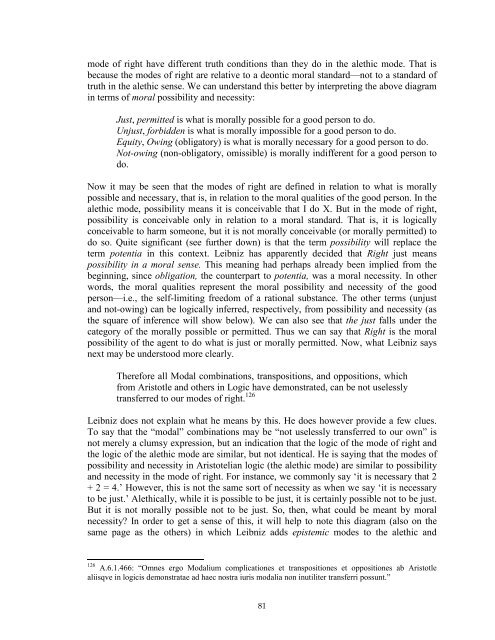Stony Brook University
Stony Brook University
Stony Brook University
You also want an ePaper? Increase the reach of your titles
YUMPU automatically turns print PDFs into web optimized ePapers that Google loves.
mode of right have different truth conditions than they do in the alethic mode. That is<br />
because the modes of right are relative to a deontic moral standard—not to a standard of<br />
truth in the alethic sense. We can understand this better by interpreting the above diagram<br />
in terms of moral possibility and necessity:<br />
Just, permitted is what is morally possible for a good person to do.<br />
Unjust, forbidden is what is morally impossible for a good person to do.<br />
Equity, Owing (obligatory) is what is morally necessary for a good person to do.<br />
Not-owing (non-obligatory, omissible) is morally indifferent for a good person to<br />
do.<br />
Now it may be seen that the modes of right are defined in relation to what is morally<br />
possible and necessary, that is, in relation to the moral qualities of the good person. In the<br />
alethic mode, possibility means it is conceivable that I do X. But in the mode of right,<br />
possibility is conceivable only in relation to a moral standard. That is, it is logically<br />
conceivable to harm someone, but it is not morally conceivable (or morally permitted) to<br />
do so. Quite significant (see further down) is that the term possibility will replace the<br />
term potentia in this context. Leibniz has apparently decided that Right just means<br />
possibility in a moral sense. This meaning had perhaps already been implied from the<br />
beginning, since obligation, the counterpart to potentia, was a moral necessity. In other<br />
words, the moral qualities represent the moral possibility and necessity of the good<br />
person—i.e., the self-limiting freedom of a rational substance. The other terms (unjust<br />
and not-owing) can be logically inferred, respectively, from possibility and necessity (as<br />
the square of inference will show below). We can also see that the just falls under the<br />
category of the morally possible or permitted. Thus we can say that Right is the moral<br />
possibility of the agent to do what is just or morally permitted. Now, what Leibniz says<br />
next may be understood more clearly.<br />
Therefore all Modal combinations, transpositions, and oppositions, which<br />
from Aristotle and others in Logic have demonstrated, can be not uselessly<br />
transferred to our modes of right. 126<br />
Leibniz does not explain what he means by this. He does however provide a few clues.<br />
To say that the “modal” combinations may be “not uselessly transferred to our own” is<br />
not merely a clumsy expression, but an indication that the logic of the mode of right and<br />
the logic of the alethic mode are similar, but not identical. He is saying that the modes of<br />
possibility and necessity in Aristotelian logic (the alethic mode) are similar to possibility<br />
and necessity in the mode of right. For instance, we commonly say ‘it is necessary that 2<br />
+ 2 = 4.’ However, this is not the same sort of necessity as when we say ‘it is necessary<br />
to be just.’ Alethically, while it is possible to be just, it is certainly possible not to be just.<br />
But it is not morally possible not to be just. So, then, what could be meant by moral<br />
necessity? In order to get a sense of this, it will help to note this diagram (also on the<br />
same page as the others) in which Leibniz adds epistemic modes to the alethic and<br />
126 A.6.1.466: “Omnes ergo Modalium complicationes et transpositiones et oppositiones ab Aristotle<br />
aliisqve in logicis demonstratae ad haec nostra iuris modalia non inutiliter transferri possunt.”<br />
81
















